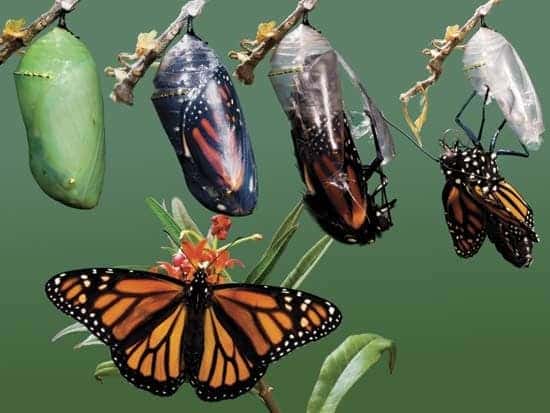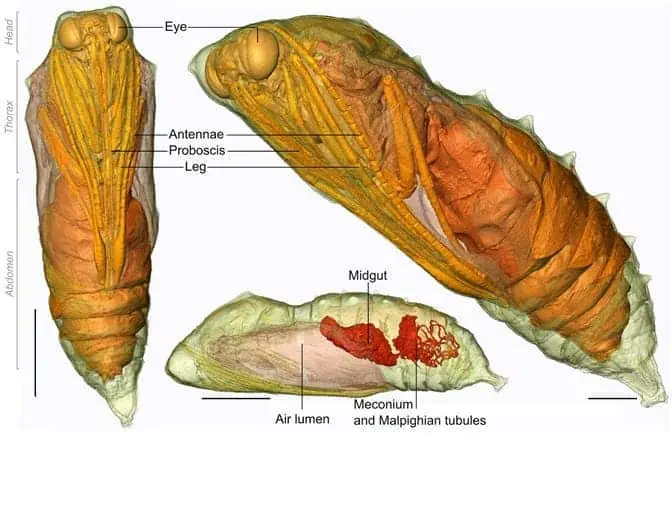The caterpillar’s metamorphosis from a tree-clinging, 12-legged pest into the majestic flying butterfly is a frequent metaphor for dramatic transformations. It’s truly a fantastic mechanism developed by nature. Yet, while it may seem fantastic from the outside, this transformation looks pretty gruesome deep inside the caterpillar’s chrysalis.
For a caterpillar to turn into a butterfly, it digests itself using enzymes triggered by hormones. Then, sleeping cells (similar to stem cells) grow into the body parts of the future butterfly. So you thought puberty was mean? Wait till you read on about the metamorphosis of a caterpillar into a butterfly.
A rough transformation

Our story begins with an egg laid by a female butterfly. These eggs are typically small and round, and can be found on the leaves of plants. Once the eggs hatch, out comes the baby caterpillar. Soon enough, the little caterpillar (scientifically known as a larva) stuffs itself with leaves, growing little by little. They eat leaves voraciously and can grow up to a hundred times their original size.
When they’ve outgrown their current skin, a hormone called ecdysone is released, instructing the larva to molt. After it molts about five times, the larva stops feeding, hangs upside down from a twig or leaf, and then either spins a silky cocoon or molts into a shiny chrysalis. This stage in the caterpillar’s life cycle is known as pupation. This process is driven by the same hormone, ecdysone, but this time it works in conjunction with the action of another hormone called the juvenile hormone. It’s actually the lack of the juvenile hormone that triggers the metamorphosis mechanism.
The juvenile hormone acts to delay metamorphosis throughout the whole larva stage. It works by blocking certain genes in the imaginal discs — tiny disc-shaped bags of cells that kick into action when the caterpillar wraps itself in the chrysalis. The imaginal discs eventually turn into antennae, eyes, wings or other butterfly bits once the caterpillar is ready for its transformation. As such, the juvenile hormone is essential to the caterpillar’s survival prior to metamorphosis. You see, once the larva reaches its final molt and begins its metamorphosis, strange things happen to its body. Cells in the larva’s muscles, gut, and salivary glands are digested and act as spare parts for the soon-to-be butterfly. Each cell is programmed to self-destruct through the activation of enzymes called caspases.

The caspases tear through the cell’s proteins, releasing prime butterfly-making material. Were it not for the juvenile hormone, this could have happened at any time, killing the caterpillar. Instead, nature programmed the hormone to lower its levels at the ideal moment for metamorphosis. With less juvenile hormone around, instead of inducing a regular molt, the ecdysone now drives the caterpillar to pupate. Once a caterpillar has disintegrated all of its tissues except for the imaginal discs, those discs use the protein-rich soup surrounding them to fuel the rapid cell division required to form the wings, antennae, legs, eyes, genitals, and all the other features of an adult butterfly or moth. The imaginal disc for a fruit fly’s wing, for example, might begin with only 50 cells and increase to more than 50,000 cells by the end of metamorphosis.
The process of metamorphosis can take anywhere from a few weeks to several months, depending on the species of butterfly. During this time, the butterfly is vulnerable to predators and environmental factors that can impede its development. But for those that make it through, the end result is a creature of unparalleled beauty and grace.
Metamorphosis isn’t just some beautiful physical transformation. It’s a stunning display of evolutionary mechanisms at work. Butterflies and caterpillars don’t just look different — they behave differently, too. One crawls on trees, and the other flies around them. Most importantly, one eats leaves, and the other solely feeds on nectar. There’s plenty of room for both kinds to coexist in the ecosystem since they don’t interfere with each other’s food stocks. It’s quite brilliant!
Inside the cocoon

Unfortunately, there is little footage that shows metamorphosis at work. The incredible photo pictured above was shot by Michael Cook, who managed to catch this Tussah silkmoth (Antheraea penyi) in a rare position – during a failed attempt to spin its cocoon. You can see the delicate, translucent jade wings, antennae, and legs of a pupa that has not yet matured into an adult moth—a glimpse of what usually remains concealed within the cocoon.
Luckily, we live in the 21st century. Using modern imaging tech, like CT scans, we can peek inside the cocoon without disturbing this extremely delicate process. The video below was shot by scientists working at London’s Natural History Museum.
The metamorphosis of caterpillars into butterflies is a wonder of nature that never ceases to amaze. It’s a reminder of the incredible adaptability and resilience of these insects, and the vital role they play in the ecosystem. Next time you see a butterfly fluttering by, take a moment to appreciate the incredible journey it has undertaken to become the beautiful creature it is today.


